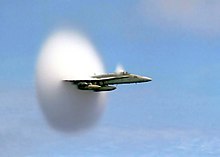Sound: Difference between revisions
m Reverted edits by 74.94.213.17 (talk) to last revision by Wikipelli (HG) |
some acustics are better than others for instance you can hear a pooping man better with a good bose sound system |
||
| Line 58: | Line 58: | ||
{{main|Acoustics}} |
{{main|Acoustics}} |
||
Acoustics is the interdisciplinary science that deals with the study of all mechanical waves in gases, liquids, and solids including vibration, sound, ultrasound and infrasound. A scientist who works in the field of acoustics is an acoustician while someone working in the field of acoustics technology may be called an acoustical or audio engineer. The application of acoustics can be seen in almost all aspects of modern society with the most obvious being the audio and noise control industries. |
Acoustics is the interdisciplinary science that deals with the study of all mechanical waves in gases, liquids, and solids including vibration, sound, ultrasound and infrasound. A scientist who works in the field of acoustics is an acoustician while someone working in the field of acoustics technology may be called an acoustical or audio engineer. The application of acoustics can be seen in almost all aspects of modern society with the most obvious being the audio and noise control industries. |
||
some |
|||
===Noise=== |
===Noise=== |
||
Revision as of 15:33, 2 May 2011

Sound is a mechanical wave that is an oscillation of pressure transmitted through a solid, liquid, or gas, composed of frequencies within the range of hearing and of a level sufficiently strong to be heard, or the sensation stimulated in organs of hearing by such vibrations.[1]
Propagation of sound
Sound is a sequence of waves of pressure that propagates through compressible media such as air or water. (Sound can propagate through solids as well, but there are additional modes of propagation). During propagation, waves can be reflected, refracted, or attenuated by the medium.[2]
The behavior of sound propagation is generally affected by three things:
- A relationship between density and pressure. This relationship, affected by temperature, determines the speed of sound within the medium.
- The propagation is also affected by the motion of the medium itself. For example, sound moving through wind. Independent of the motion of sound through the medium, if the medium is moving, the sound is further transported.
- The viscosity of the medium also affects the motion of sound waves. It determines the rate at which sound is attenuated. For many media, such as air or water, attenuation due to viscosity is negligible.
When sound is moving through a medium that does not have constant physical properties, it may be refracted (either dispersed or focused).[2]
Perception of sound

The perception of sound in any organism is limited to a certain range of frequencies. For humans, hearing is normally limited to frequencies between about 20 Hz and 20,000 Hz (20 kHz)[3], although these limits are not definite. The upper limit generally decreases with age. Other species have a different range of hearing. For example, dogs can perceive vibrations higher than 20 kHz, but are deaf to anything below 40 Hz. As a signal perceived by one of the major senses, sound is used by many species for detecting danger, navigation, predation, and communication. Earth's atmosphere, water, and virtually any physical phenomenon, such as fire, rain, wind, surf, or earthquake, produces (and is characterized by) its unique sounds. Many species, such as frogs, birds, marine and terrestrial mammals, have also developed special organs to produce sound. In some species, these produce song and speech. Furthermore, humans have developed culture and technology (such as music, telephone and radio) that allows them to generate, record, transmit, and broadcast sound.
Physics of sound
The mechanical vibrations that can be interpreted as sound are able to travel through all forms of matter: gases, liquids, solids, and plasmas. The matter that supports the sound is called the medium. Sound cannot travel through a vacuum.
Longitudinal and transverse waves

Sound is transmitted through gases, plasma, and liquids as longitudinal waves, also called compression waves. Through solids, however, it can be transmitted as both longitudinal waves and transverse waves. Longitudinal sound waves are waves of alternating pressure deviations from the equilibrium pressure, causing local regions of compression and rarefaction, while transverse waves (in solids) are waves of alternating shear stress at right angle to the direction of propagation.
Matter in the medium is periodically displaced by a sound wave, and thus oscillates. The energy carried by the sound wave converts back and forth between the potential energy of the extra compression (in case of longitudinal waves) or lateral displacement strain (in case of transverse waves) of the matter and the kinetic energy of the oscillations of the medium.
Sound wave properties and characteristics
Sound waves are often simplified to a description in terms of sinusoidal plane waves, which are characterized by these generic properties:
- Frequency, or its inverse, the period
- Wavelength
- Wavenumber
- Amplitude
- Sound pressure
- Sound intensity
- Speed of sound
- Direction
Sometimes speed and direction are combined as a velocity vector; wavenumber and direction are combined as a wave vector.
Transverse waves, also known as shear waves, have the additional property, polarization, and are not a characteristic of sound waves.
Speed of sound

The speed of sound depends on the medium the waves pass through, and is a fundamental property of the material. In general, the speed of sound is proportional to the square root of the ratio of the elastic modulus (stiffness) of the medium to its density. Those physical properties and the speed of sound change with ambient conditions. For example, the speed of sound in gases depends on temperature. In 20 °C (68 °F) air at the sea level, the speed of sound is approximately 343 m/s (1,230 km/h; 767 mph) using the formula "v = (331 + 0.6 T) m/s". In fresh water, also at 20 °C, the speed of sound is approximately 1,482 m/s (5,335 km/h; 3,315 mph). In steel, the speed of sound is about 5,960 m/s (21,460 km/h; 13,330 mph).[6] The speed of sound is also slightly sensitive (a second-order anharmonic effect) to the sound amplitude, which means that there are nonlinear propagation effects, such as the production of harmonics and mixed tones not present in the original sound (see parametric array).
Acoustics
Acoustics is the interdisciplinary science that deals with the study of all mechanical waves in gases, liquids, and solids including vibration, sound, ultrasound and infrasound. A scientist who works in the field of acoustics is an acoustician while someone working in the field of acoustics technology may be called an acoustical or audio engineer. The application of acoustics can be seen in almost all aspects of modern society with the most obvious being the audio and noise control industries. some
Noise
Noise is a term often used to refer to an unwanted sound. In science and engineering, noise is an undesirable component that obscures a wanted signal.
Sound pressure level
| Sound measurements | |
|---|---|
Characteristic | Symbols |
| Sound pressure | p, SPL, LPA |
| Particle velocity | v, SVL |
| Particle displacement | δ |
| Sound intensity | I, SIL |
| Sound power | P, SWL, LWA |
| Sound energy | W |
| Sound energy density | w |
| Sound exposure | E, SEL |
| Acoustic impedance | Z |
| Audio frequency | AF |
| Transmission loss | TL |
Sound pressure is the difference, in a given medium, between average local pressure and the pressure in the sound wave. A square of this difference (i.e., a square of the deviation from the equilibrium pressure) is usually averaged over time and/or space, and a square root of this average provides a root mean square (RMS) value. For example, 1 Pa RMS sound pressure (94 dBSPL) in atmospheric air implies that the actual pressure in the sound wave oscillates between (1 atm Pa) and (1 atm Pa), that is between 101323.6 and 101326.4 Pa. Such a tiny (relative to atmospheric) variation in air pressure at an audio frequency is perceived as a deafening sound, and can cause hearing damage, according to the table below.
As the human ear can detect sounds with a wide range of amplitudes, sound pressure is often measured as a level on a logarithmic decibel scale. The sound pressure level (SPL) or Lp is defined as
- where p is the root-mean-square sound pressure and is a reference sound pressure. Commonly used reference sound pressures, defined in the standard ANSI S1.1-1994, are 20 µPa in air and 1 µPa in water. Without a specified reference sound pressure, a value expressed in decibels cannot represent a sound pressure level.
Since the human ear does not have a flat spectral response, sound pressures are often frequency weighted so that the measured level matches perceived levels more closely. The International Electrotechnical Commission (IEC) has defined several weighting schemes. A-weighting attempts to match the response of the human ear to noise and A-weighted sound pressure levels are labeled dBA. C-weighting is used to measure peak levels.
Equipment for dealing with sound
Equipment for generating or using sound includes musical instruments, hearing aids, sonar systems and sound reproduction and broadcasting equipment. Many of these use electro-acoustic transducers such as microphones and loudspeakers.
Sound measurement
- Decibel, Sone, mel, Phon, Hertz
- Sound pressure level, Sound pressure
- Particle velocity, Acoustic velocity
- Particle displacement, Particle amplitude, Particle acceleration
- Sound power, Acoustic power, Sound power level
- Sound energy flux
- Sound intensity, Acoustic intensity, Sound intensity level
- Acoustic impedance, Sound impedance, Characteristic impedance
- Speed of sound, Amplitude
See also
- Acoustics
- Academic Programs in Acoustics
- Auditory imagery
- Audio bit depth
- Audio signal processing
- Beat
- Diffraction
- Doppler effect
- Echo
- Music
- Musical tone
- Note
- Phonons
- Physics of music
- Pitch
- Psychoacoustics
- Resonance
- Refraction
- Reflection
- Reverberation
- Signal tone
- Sonic weaponry
- Sound localization
- Soundproofing
- Structural acoustics
- Timbre
- Ultrasound
- List of unexplained sounds
References
- ^ The American Heritage Dictionary of the English Language, Fourth Edition, Houghton Mifflin Company, 2000, archived from the original on June 25, 2008, retrieved May 20, 2010
- ^ a b http://www.jhu.edu/virtlab/ray/acoustic.htm
- ^ http://books.google.com/books?id=RUDTFBbb7jAC&pg=PA248
- ^ APOD: 19 August 2007 – A Sonic Boom
- ^ http://www.eng.vt.edu/fluids/msc/gallery/conden/mpegf14.htm
- ^ The Soundry: The Physics of Sound
External links
- Sounds Amazing; a KS3/4 learning resource for sound and waves
- HyperPhysics: Sound and Hearing
- Introduction to the Physics of Sound
- Hearing curves and on-line hearing test
- Audio for the 21st Century
- Conversion of sound units and levels
- Sound calculations
- Audio Check: a free collection of audio tests and test tones playable on-line
- More Sounds Amazing; a sixth-form learning resource about sound waves




